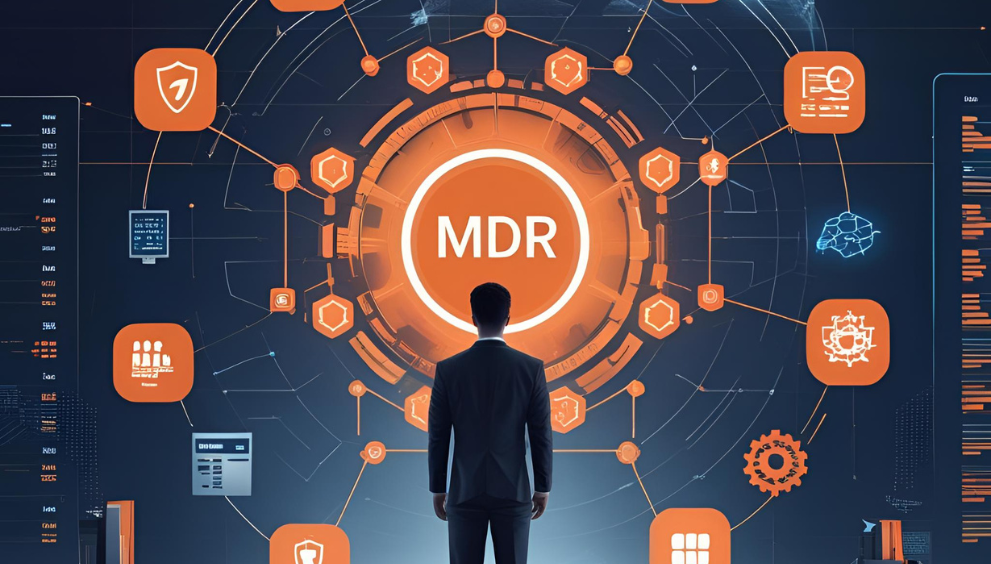Cyberattacks have become more silent, more clever, and often impossible to spot until it’s too late. While traditional antivirus software may detect known threats, today’s hackers don’t always follow old patterns. That’s where Managed Detection & Response, or MDR, steps in.
MDR is not just another buzzword in cybersecurity. It marks an imminent change in the way organisations identify, interpret, and handle complicated attacks. Regardless of whether you are a small business operator or a member of an enterprise, knowledge of MDR and the way it can help to secure your digital sphere has become crucial like never before.
Understanding MDR: A New Age Cybersecurity Solution
So, what exactly is MDR?
Managed Detection and Response items are security services that are accompanied by technology, expertise and continuous monitoring of threats. It is not merely blocking viruses anymore; it is constantly scanning your systems, checking suspicious behaviour, abnormal patterns, and surprising threats.
Contrary to even the traditional security systems that usually emphasise wall construction, MDR seeks and finds evidence of trouble within or behind the walls, in a very limited and ongoing process. It has innovative tools; however, it also has real individuals working behind it to analyse alerts, investigate activities, and act upon something that does not seem right.
In simple words, MDR cybersecurity is like having a team of skilled security professionals watching your digital space 24/7 and ready to jump in if something goes wrong.
Key Components of an MDR Strategy
To understand the strength of MDR, let’s look at what makes it tick:
- Threat Intelligence: Constant updates about emerging threats and global cyberattack patterns.
- Human Analysts: Skilled professionals who examine alerts, study behaviour, and make decisions when needed.
- Automation Tools: Smart software that flags anything suspicious in real time.
- Incident Response Framework: Plans and processes are ready to go when an attack happens.
All these elements come together to give organisations fast, focused protection beyond what traditional tools can offer.
Proactive vs Reactive Security Approaches
Traditional security systems work reactively. They act only after something bad happens. By then, damage may already be done.
MDR flips this around. It focuses on proactive security. Instead of waiting, it constantly searches for warning signs and potential breaches.
It’s the difference between installing a lock on your door and having someone guard it day and night. MDR watches and responds in real time, sometimes even before a threat fully develops.
MDR and Compliance Requirements
In industries like healthcare, finance, and e-commerce, there are strict rules about how data should be protected. Think GDPR, HIPAA, or ISO standards.
MDR can help meet these rules. With its continuous monitoring, real-time reporting, and clear incident response methods, organisations can show that they’re taking proper steps to keep data safe. That’s a big plus during audits or when applying for certifications.
Why Traditional Security Fails Against Advanced Threats?
Today’s threats are not like the ones we saw five years ago. Attackers now use stealth, automation, and deep research. Many of them avoid detection for days or weeks.
Types of attacks that often slip through:
- Advanced Persistent Threats (APTs): These attackers don’t just hit and run. They stay hidden in your systems for a long time.
- Zero-Day Attacks: Exploits that target unknown weaknesses — even before developers can fix them.
- Fileless Malware: Threats that don’t use traditional files, making them hard for antivirus programs to detect.
Traditional systems rely heavily on known threat signatures. If the malware doesn’t match a known pattern, it slips past. That’s where MDR makes a huge difference.
How MDR Enhances Threat Detection and Response
Let’s now explore the actual benefits of MDR security in plain terms.
MDR combines artificial intelligence, behaviour monitoring, and human skill to look deeper and respond faster. It doesn’t just focus on stopping threats; it works to understand and contain them.
Real-Time Monitoring and Threat Detection
With MDR, your systems are monitored 24/7. This means threats are not missed just because they happen early morning.
Constant visibility helps in:
- Spotting threats the moment they appear.
- Reducing the time attackers stay hidden.
- Making sure nothing slips through over weekends or holidays
This round-the-clock coverage means someone is always watching, even when your IT team is not.
AI and Behavioural Analytics in MDR
Traditional systems ask: “Does this file match any known virus?”
MDR systems go one step further: “Is this behaviour unusual for this user or system?”
That’s where AI and behavioural analytics come in. The system learns what “normal” looks like for your network. When something odd happens, like a user logging in from a strange location or accessing sensitive data at an unusual time, it triggers a deeper investigation.
This approach is powerful against stealthy threats that avoid detection by acting like normal users.
Rapid Incident Response and Containment
When something bad is found, timing is everything.
MDR services cybersecurity are built for speed. Once an attack is confirmed, the system and analysts work together to:
- Isolate affected systems.
- Stop the threat from spreading.
- Start remediation actions immediately.
This quick reaction prevents larger damage and keeps business operations stable.
Quick Heal’s Role in MDR Services
As cybersecurity threats grow more advanced, Quick Heal has taken steps to go beyond just antivirus.
The company’s MDR services are designed to offer Indian businesses a complete threat detection and response solution. From small setups to large enterprises, Quick Heal’s approach focuses on flexibility, precision, and speed.
It’s not just about tools, it’s about combining people, processes, and technology to deliver complete protection.
Threat Lifecycle Coverage
Quick Heal’s MDR solution doesn’t just respond to attacks. It handles the entire threat lifecycle, from early detection to final clean-up.
This includes:
- Threat hunting
- Alert verification
- Response actions
- Recovery planning
- Post-incident analysis
This end-to-end coverage helps reduce threat dwell time and ensures the same problem doesn’t come back.
Customer Support and Incident Response Timelines
Quick Heal offers clear support structures and defined timelines for incidents.
That means:
- Fast response during critical attacks
- Dedicated experts handling complex cases
- Service Level Agreements (SLAs) that prioritise urgency
Whether it’s a breach or just a suspicious alert, the MDR team stays connected till the issue is resolved.
Real-World Benefits for Quick Heal MDR Customers
Organisations that have adopted Quick Heal’s MDR have seen tangible benefits, including:
- Faster threat detection: No more waiting hours or days
- Lower incident impact: Attacks are stopped before spreading
- Improved SOC performance: Less alert fatigue and more accurate investigations
Quick Heal’s approach gives customers peace of mind by reducing the pressure on in-house teams and providing expert support whenever needed.
Future-Proofing Cybersecurity with MDR
As threats evolve, so should our defences. Managed Detection and Response is no longer optional, it’s the foundation of modern cybersecurity.
With attackers becoming smarter and tools becoming more complex, businesses need more than just antivirus. They need intelligence, monitoring, and rapid action, all rolled into one.
Quick Heal is committed to offering Indian businesses a future-ready defence with MDR services, integrated with offerings like Total Security, Fraud Prevention Solution, and its ever-growing cybersecurity knowledge base.
Frequently Asked Questions
-
Why is MDR so important?
MDR provides organisations with an opportunity to identify and react to threats within a short period. It prevents expensive downtime, decreases risk and keeps systems under round-the-clock monitoring.
-
How does MDR help detect advanced threats?
MDR looks beyond known threats. It uses behavioural analysis, AI, and expert review to find patterns that traditional systems miss, especially in complex or stealthy attacks.
-
What are stealthy cyber threats, and how can MDR detect them?
Stealthy threats are attacks that hide from traditional defences by acting like normal user behaviour. MDR detects them by watching for changes in behaviour or activity that don’t match expected patterns.
-
Does MDR provide real-time threat monitoring?
Yes, MDR provides 24/7 monitoring. It makes threats easy to identify, whether at the office or not, and therefore less time is spent by attackers without being detected.



